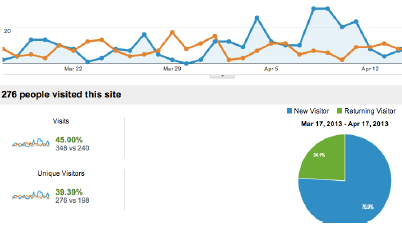 Bulletin, April 2013
Bulletin, April 2013
The Latest in Area Economic and Technical Trends
Exclusively to Clients and Friends of Advanced Practice Management
A Disappointing Dental Dow:

Total exams were even with last year but new patients were down about 11%. Doctor hours cancelled were up about 6%, however, hygiene hours cancelled were down 2%. The production per exam was down 2%.
About 20 of the sampled mature practices showed declines, and 15 showed gains in production. 25 showed decreases in collections (however, the decrease in collections may be related to fewer practices “holding over” collections into the new year, anticipating higher tax brackets this year).
This is in stark contrast to the first quarter of 2012 when production was up 5.7% and collections were up 4.6% (compared to the first quarter of 2011). And, you may recall, for the year 2012, production and collections were up about 3.3%.
I was unpleasantly surprised with this Dental Dow. I’ve had a lot of clients tell me that they felt that patients were finally loosening up their purse strings. I still believe they are or soon will be, but we are off to a soggy start this year in more ways than one!
As I’ve said a thousand times before, the dental economy has not been much help but you still have far more control over your practice then the economy, Delta, or the weather does. It would be nice though to have more of a tailwind and less of a headwind!
Offering Patients (And Potential New Patients) Alternatives To Insurance:
We are starting to see more successes with Dentists offering patients alternatives to insurance. Often pitched “No Insurance – No Problem” these plans typically consist of variations like:
- $280 Annual Membership – Two prepaid checkups per year (exam, x-rays, prophy and fluorides) and 15% off all other services.
- $79 Annual Membership for 15% off all services.
- “A Seniors Plan” – Essentially the same thing but focused on Seniors (most do not have insurance).
We have found the following benefits in offering these plans to patients:
- Continuing Care Visits. People who are prepaid tend to keep their visits. That helps patient flow.
- Case Acceptance. The discount encourages the patients to go ahead with proposed treatment while they are eligible for the deal: A patient enrolls for $280. That patient goes ahead with their bridge. They save $500 on their bridge which pays for their checkups. Making dentistry more affordable is a good deal for the patient and good for the office too.
- New Patients. This gives a practice an entry way to a new and potentially substantial market segment (more about that below).
Big insurance goes after big companies. So Delta goes after 3M, MetLife after Target, etc. These big insurance companies generally don’t send their representatives to visit with small businesses. It just isn’t worth it for them.
Yet most people work for small businesses! Chances are, there are scores, if not hundreds of small businesses within a five mile radius of your office. This is the new, new patient market we are going after. If you can offer a free or low cost “perk” for their employees, you have the potential to enroll your business neighbors just as Delta, MetLife and Cigna “capture” the people who work for big businesses. Except now, instead of insurance/PPO paperwork, restrictions and write-offs, you have your own plan and your own patients. The idea here is to become your area’s “Practice to Business Provider.”
I can foresee the day where independent practices will have their own “representative” as a liaison to local businesses in the area.
Our associate, Robyn Kain, has hit the streets on behalf of four offices in just the last month or so. She simply walks into the business (“sales calls”) and invites people into the practice. She typically brings in 2-6 patients just from that morning’s work. However, these personal visits aren’t the total picture. It’s the beginning of a campaign.
I’ve personally been working with approaches like this since the ‘80’s, however, things haven’t really caught on until now. To make things work, you and your team have to really talk things up and promote them in the practice.
We can help launch your own alternatives. Don’t even think about it unless you and your staff are willing to put a little bit of energy into it. Talk to us about it at our next meeting.
Getting Paid For After Hours Office Visits:

If you occasionally see patients “after-hours”, you can charge for that in addition to the treatment fee(s) for the specific services rendered. Insurance will not typically cover this, so the patient will be responsible for payment. Fees for 9440 typically range from $75-$160. It is not at all unreasonable for you to use this code, especially when you have to also bring in staff after hours.
SEO Or Paid Advertising?:

In the long run these are all good practices, but they take a lot of work and persistence. Unfortunately, we do not always see practices who are putting in this effort rank at the top of Local Search (Google Places/Map program). This can be very frustrating and we do our best to keep you on top of the nuances of Google’s Local Search and Google+ developments (If you would like to enroll to receive Kelly’s blogs and notifications, please email kelly@advancedpracticemanagement.webaloo.com.)
In highly competitive areas (e.g., big cities like Minneapolis. & St. Paul), we have come to the conclusion that it can be worth just paying to be higher in the search order (through Google’s Pay-Per-Click AdWords or Adwords Express programs) to supplement basic SEO. In many cases, we recommend at least experimenting to see if it works for you in your market. See the example below.
After Adwords Express: Visits in one month went up 45%(note the blue line).
It is also increasingly important that your website must be more like an advertisement and less like a brochure. According to the analytics we watch on numerous websites, people spend 1-3 minutes on a website and often do not wander farther than the Home and Contact pages. Today’s audience is accustomed to quick information. You work hard to get folks to your website. Once you get them there, you have to engage them and quickly give them a reason to contact you. There has to be a call to action so that when someone lands on your website, they are enticed to pick up the phone or e-mail.
This can be a special offer, click through to contact, social icons, “your questions answered” or even patient video testimonials, and it has to “pop.”
For sure, you don’t want just generic pictures of generic people on Flash (which slows down loading) and just means that they don’t see anything or any reason to go with you. Then it’s “click” and onto the next practice website!
We recommend setting up a budget of $300-$500/mo. to help yourself get found if you are in a highly competitive area. But don’t even bother going with paid Internet advertising unless you have some type of offer or incentive to encourage potential patients to go from “click” to “call!”
No Safety in Numbers – Avoid Advertising Groups. There are a lot of groups that talk about putting you in an online directory, like “Ad Alliance” Dex, Yellow Pages or other variations where they bundle you in with other providers or other local merchants.
We don’t believe that people use Google or Yahoo to get lists of lists. They do it to actually find a plumber, dentist, hotel, or whatever. So, we don’t think these paid directories are worthwhile.
Save your money for more reasonable bets and for promoting your marketing presence.
PPO Plays:
Decisions regarding PPO participation, transition to or from a PPO can be among the most expensive or profitable you can make.
These issues are too complex, serious and controversial to discuss in this format.
In my opinion, Doctors are often too quick to join a PPO and sometimes too quick to drop. By making the right “PPO Plays”, we’ve helped clients add $1,000s of dollars to their bottom lines. On the other hand, we have seen Doctors do serious damage to their practices from handling these transitions or negotiations incorrectly.
So, if you are dealing with PPO/Insurance companies (and who isn’t?), please discuss things with us before you make your move.
Sincerely,

Telephone: 952-921-3360
Email: APM@AdvancedPracticeManagement.com
Website: AdvancedPracticeManagement.com



